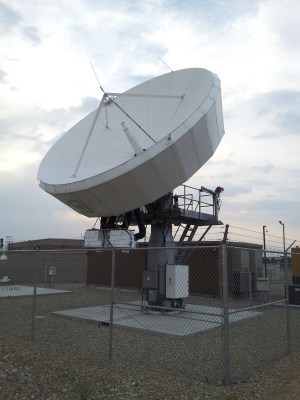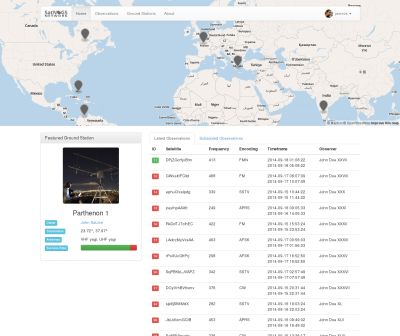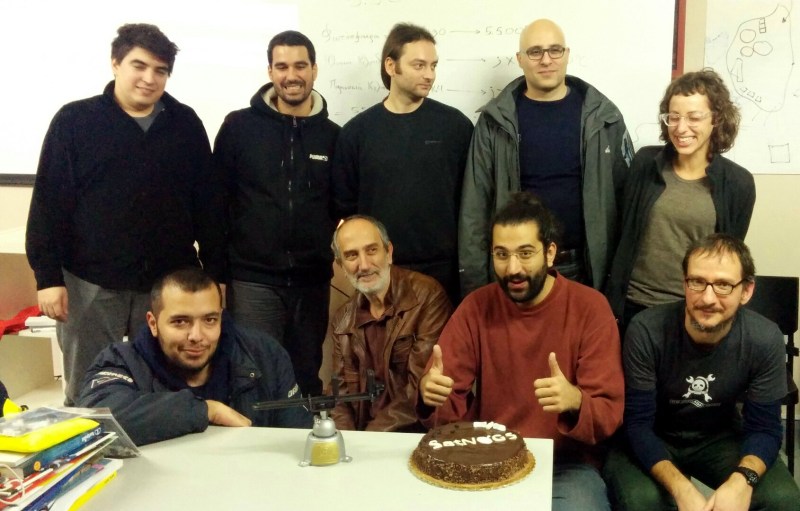When you think of satellites, you may think of the Space Shuttle extending its robot arm with a huge piece of high-tech equipment waiting to pirouette into orbit. This misconception is similar to picturing huge mainframes when thinking about computers. The future (and arguably even the present) reality of satellites is smaller, cheaper, and more prolific. This future is also an “open” one if the Libre Space Foundation has anything to say about it.
This group that plans to make satellite communications available to anyone started out as a build at a hackerspace. One good idea, a shared set of skills and experience, and a little bit of time led them to accomplish amazing things. We are, of course, talking about the Grand Prize winners of the 2014 Hackaday Prize. The SatNOGS team built a working satellite ground station and laid the foundation for a data-sharing network to connect to it. But even this description can be a bit daunting, so come with me to learn what this is all about, and how it matters to you.
Crowd-Sourcing Satellite Ground Stations

Satellite ground stations have been around as long as satellites have. It’s simply the antenna that communicates with satellites in space. The traditional model is a huge dish, sometimes enclosed in a white dome.
There are several things to consider. First, a single ground station can only stay in contact with a satellite if it is in geostationary orbit (meaning the satellite is always above the same point on the earth). Dishes pointing at these satellites are in near-constant communication with these satellites. Want to get some time on this thing? Fat chance!
Secondly, satellites which are not locked in synchronous orbit are only in contact with a single ground station for a small portion of each pass. Eventually the planet gets in the way and you need a ground station on a different part of the globe to communicate with it while you are in blackout.

The SatNOGS project seeks to address both of the issues just mentioned. It starts with the hardware; an Open Design which can be built at a minimum of cost using readily available tools and a reasonable skillset. Bootstrapping your own receiver is one way to guarantee your access to a ground station. But if you’re also willing to share some of that time with others you unlock the solution to the second problem.
The SatNOGS project allows multiple ground stations to synchronize their data and to schedule time on each instance of the hardware around the world. A ground station must point at the right place at the right time for any given satellite. The platform design accounts for this by sending scheduling data back to each ground station which will automatically adjust its aim to line up with the next satellite capture request.
Building the network is key. As more people build and deploy their own hardware, everyone gets a bigger piece of the satellite data as it is collected.
This is Bigger than SatNOGS: Libre Space Foundation
 From the description above we’re sure you agree that this has the potential to be much more than a project between a few friends. This is a movement. The SatNOGS team came to this realization early on and conceived of an organization to help illuminate the path. The Libre Space Foundation was formed with the idea that all of satellite communications should have an Open model. This means the satellites themselves, the ground stations, and the data.
From the description above we’re sure you agree that this has the potential to be much more than a project between a few friends. This is a movement. The SatNOGS team came to this realization early on and conceived of an organization to help illuminate the path. The Libre Space Foundation was formed with the idea that all of satellite communications should have an Open model. This means the satellites themselves, the ground stations, and the data.
We already mentioned the Grand Prize, which was of course a trip into space. We were really hoping that we’d see a hacker sign up for such an adventure, but we’re thrilled with the alternative. The SatNOGS team went with the cash option of $196,418 and chose to invest it in the Libre Space Foundation (LSF). This is a great jump-start but the LSF needs more than just cash to succeed. They need people to adopt and further their vision.
CubeSats

Private industry has been in on the action as well. Planet Labs has launched what they call “flocks” of these small satellites which work together to form something of a line-scanner for the planet. The system images the entire earth once every 24 hours.
Already there are proofs of concept that all point to personal satellites. That’s right, you can own a satellite. Just like the two previous examples; built it small, and launch it as extra cargo. We saw a very successful crowd funding campaign just a couple of years ago on the topic. And our own Hackaday.io has numerous satellites, warranting a roundup of them all.
The Satellite Data
 What kind of data can you get from these satellites? It’s easy to assume that all of this is encrypted and proprietary but that’s simply not the case. Sure, media and communications satellites are not going to dump the latest episode of Game of Thrones into your home-built ground station. But there are a lot of satellites that are broadcasting useful data in the open.
What kind of data can you get from these satellites? It’s easy to assume that all of this is encrypted and proprietary but that’s simply not the case. Sure, media and communications satellites are not going to dump the latest episode of Game of Thrones into your home-built ground station. But there are a lot of satellites that are broadcasting useful data in the open.
To name one very interesting source, the National Oceanic and Atmospheric Administration (NOAA) has a collection of satellites monitoring weather and transmitting the data back to earth. Recording these transmissions is a trick we’ve seen many times over the years.
One that we’ve seen less often is grabbing data sets from research satellites like those launched by University programs. Getting your hands on the data without waiting for the researchers’ publication means more opportunities for peer-review and better access for educational purposes.
The potential is also there to form your own communications networks. Right now SatNOGS hardware is a receive-only unit. But the software stack is ready for transmit and receive. This will that the DVB-T dongle be swapped for something with a transmitter, and more than likely will call for licensure in most areas (for example, an amateur radio license) but these are not large hurdles to cross. As mentioned, the LSF has hopes of developing Open Hardware and Open Source Software designs for satellites. Imagine your own data network. In Space. Now that is a brave new world.
Here’s How You Can Help
We like to dream big and it excites us that the LSF is doing just that. But they need your help.
Version 3 of the SatNOGS ground station is in development and they can use experts in all areas to help. Most notably, RF design to help improve communications, as well as mechanical design to ensure the build will stand up to time and weather. Check out the SatNOGS community for more on getting involved directly.
Don’t have the skills to build these yourself? Don’t worry, just spreading the word is a big way to help. Give a talk at your local Hackerspace, or just pester all of your neighbors. It’s space, everyone wants to hear about that, right?

















I’m still vague on exactly what data is being collected here. “Weather data” is almost as vague as “experiments in zero-gravity”, which is almost as vague as “research satellites”.
What sort of data is actually being collected here? Can anyone give me a solid example?
“Weather data” is ambiguous because the sky’s the limit! Haha (aren’t I funny? =). Seriously though, it’s probably exactly what you think it is: Weather satellites collect all sorts of data–not just images of the earth.
Want to check the size of hole in the ozone? There’s probably a satellite (or three) broadcasting data about that. What to know how much methane is being emitted from fracking activity in your area? There’s probably satellites you can use.
Explaining “experiments in zero-gravity” is a bit more complicated but I’ll give you a real-world example: NASA and the European Space Agency are jointly working on a project to detect gravity waves:
http://en.wikipedia.org/wiki/Laser_Interferometer_Space_Antenna
Later this year they’re going to launch a small test satellite, the LISA Pathfinder:
http://en.wikipedia.org/wiki/LISA_Pathfinder
Presumably, if you have the right equipment (e.g. a SatNOGS ground station) you could capture the data sent back from the two probes and know if and when a gravity wave is detected! You’d know the news at the same time that the scientists know and probably *days* before it’s announced in the media (which would be cool as hell and possibly give you an advantage in market trading! Oops, did I just say that? =).
That’s just *one* of many zero-gravity experiments that are going to be taking place in the near future. Nearly all of them will involve some data being broadcast back to Earth. Data you can capture with a cheap, open source ground station.
…but that’s just the “passive observer” stuff. The real fun comes when you send your own satellite(s) into space which will be a very real thing in the near future. Especially when you consider the advantages such a thing can provide. For example, your very own free-to-operate data relay/Internet anywhere connection (well, at certain times of day haha). Or you could take it upon yourself to capture “proper” images of all those things that get blurred/edited out on Google maps.
What is the cost of the finished article? Are there any impediments to making it? Need 3D Printer etc? — Can it be done with readily attainable off the shelf components?
I can’t speak to cost, but the team is working to make as many items off-the-shelf as possible. I just read a thread on their hardware forum about trying to source the enclosure for world-wide availability.
The original prototype did use some 3d printed parts. The gears responsible for movement and mounting brackets for them come to mind.
Are there any ballpark figures? under $100/200? — I appreciate the reply, thanks.
Post your Libre satellite designs on http://www.Libre3D.com :-)
“Sure, media and communications satellites are not going to dump the latest episode of Game of Thrones into your home-built ground station. But there are a lot of satellites that are broadcasting useful data in the open.”
I’m a bit surprised this doesn’t have a link to FTA Satellite information. You can pull Full HD PBS, The Pentagon Channel (military’s media channel ala Stars and Stripes for TV), as well as live feeds from field reporters for CNN, ABC, NBC and CBS, et al. You can also get a few English language news channels from around the world (like RT and CNC – you used to be able to get Al Jazeera until they killed that feed.)
Also exciting is the ability to receive Outernet using the same hardware, a supported DVB-S receiver and a Raspberry Pi!
Incidentally, the licensing referenced in the article is most likely intended to be an amateur radio license. Even with the intro level license in the US (Technician) you can transmit to satellites operating in the ham bands (which there are dozens of).
The SatNOGS ground station is also remarkably similar to the WA8SME WRAPS setup that tracks satellites as they transmit. So check out that setup if you’re looking to build your own station.
Yes, there are some similarities between the two, but Mark’s design is intended for use with commercially built antennas, rather than an entirely home-built system. He also used a PIC instead of an Arduino Micro.
A little disappointed to hear that V3 of the ground station is in the works. I just started buying the parts to build V2…
Such are the results of active development.
Nice move to get the hackaday money earlier without fulfilling any actual milestones…
Agreed. This smells of being “rigged” ! (wonder if this will get posted?)
For this – uhm, ‘prize winning’ project to work, you need a hell of a lot of people signing up to build “ground stations”. Otherwise, it’s a perfect example of vaporware. An equivalent of this in the public safety community is “FirstNet” (which is supposed to be a nationwide broadband network for police, fire, EMS). Without sufficient sites to provide an adequate footprint for wireless coverage, it’s a massive taxpayer boon doggle (a “solution” looking for a problem).
The sycophant butt kissers here worshipping this so called “prize winning” project is sickening !
I really like there passion to work on a space project, but now it’s two, and two big ones. I still ask myself whether or not hackaday will even check on what the money is spent, or if it will be just “gone” at the end of this year with two unfinished projects… :(
I can, because the team that developed this isn’t limited to Americans, if there are even any on it. We need to get over this myopic view that other cultures MUST bow to the will of an offended minority, especially when the apparently offensive term is used as an Acronym, which is the case here.
Poe’s Law, everybody. Remember Poe’s Law.
How do you know I didn’t have the same thing happen to any of my distant cousins? My maternal grandfather’s family was from Poland, for what it’s worth, and there were a lot of people from there that ended up in the camps.
I can’t tell if you’re serious. Is it really? I’ve never heard that term in the U.S.
What does it mean and why is it offensive?
In any case, I don’t think they meant to do that, as it seems the NOGS portion of SatNOGS is an acronym.
If anything it’s like Chevy trying to sell the Nova in Mexico and not realizing why nobody bought it.
Good for you for admitting you had never heard of it. Neither had I. Too often when someone is accused of using an obscure racial insult, bystanders pretend that they had heard of it because they do not want to appear naive or ‘insensitive’. This is unfair to the accused because it makes it look like everyone knew the expression could be offensive and so he must have used it deliberately.
It looks like Bernstein may parodying this behavior. He is claiming that the satellites are named after an obscure regional insult of which few have heard. He is hoping we will go off and Google it, find it at the bottom of the first page, and then pretend we knew all along.
Nice trolling, Bernstein. Like we should show our racial sensitivity by learning all the obscure regional racial insults we can. If when you read “NOG” you think of a character from Star Trek or Northern Oil and Gas, or eggnog, or shipbuilding, or mine shoring, then you know you are a racist!
looks like it would be hard for not to offend someone with every word we use giving the list of insults .
http://www.thebirdman.org/Index/Others/Others-Doc-Race&Groups-General/+Doc-Race&Groups-General-General&Msc/RacistTerms&Origins.htm
Who gives a flying F ? Get over it ! too many “politically correct” pansies out there nowadays always whining about “oh my poor little itty bitty feelings were hurt”….man up and grow a set ! or dish it right back instead of crying like a little girl.
Yes, that’s the American way.
Fortunately, most of us out in the world are not American.
Good work TrollBernstein. You’ve taken the passion of thousands of techies and tried to attach a bad rap to it. State your real name, someone should come spank your fanny.
Comrade Bernstein has me confused. I always thought people were gassed in a gas chamber, as opposed to burned alive which I always assumed would need some sort of oven. Tragic either way because if it carries on there’s going to be no trolls left.
Firstly- Whilst I am *VERY* hesitant to lightly suggest modding even trolls- when it becomes a noise flood- PLONK with the Garbage so we get back to tech… If I appear to mention “Politics” even obliquely- It’s to BANISH POLITICS from our evaluations:>
SatNOGS is worthy of our collective and ROBUST participation on so many levels that it might indeed be to this century’s Hackerfolk as Sputnik itself was to our predecessors. And the comparison seems spot on. SAME sort of captures our collective emotions to arouse intellects and inspire us.
I personally can see participation in SatNOGS as almost Dare I say- an Ethical Duty of Hackerfolk. IF we have a Peaceful Alliance of Independent sources for cross checking received data= it could make trust levels go up a bit.